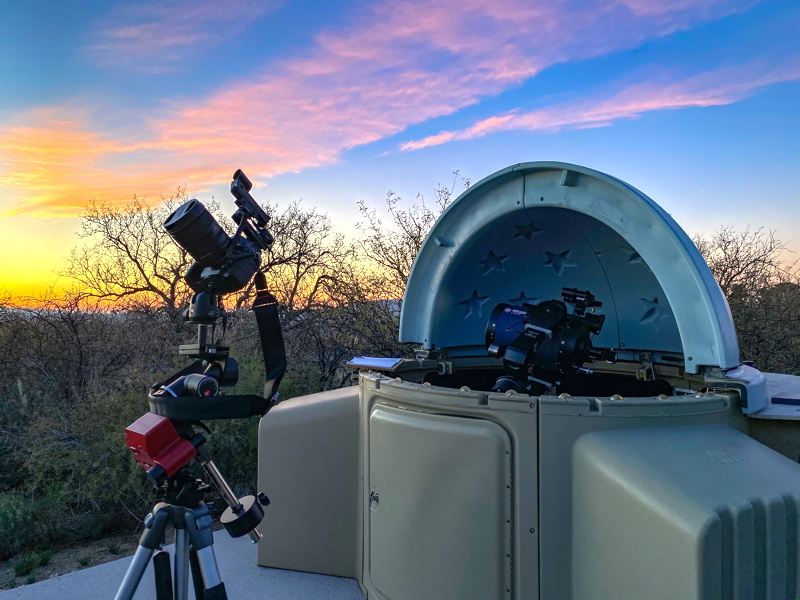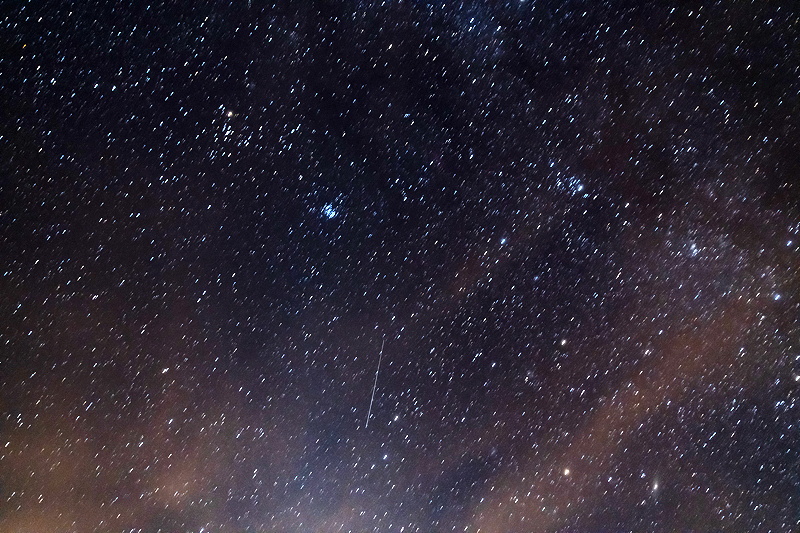SpaceX Starlink Satellites, Neighbor Lights
Posted: 17 February 2020
|
Open: Sunday, 16 February 2020, 1802 MST Temperature: 76°F |
Session: 1439 Conditions: Mostly clear |
Equipment:
12" f/8 LX600 w/StarLock
2" 24mm UWA eyepiece
SkyTracker Pro
Camera:
D850 DSLR
1809 MST: LX600 ON, StarLock OFF, High Precision OFF.
Although there were some clouds in the sky I wanted to try to observe and photograph some SpaceX Starlink satellites from the November 2019 launch. They should be at or near their final orbital altitude.
I set up my D850 DSLR on the iOptron SkyTracker Pro (STP) on the observatory patio.

1826 MST: I returned to the 12" telescope and viewed the planet Mercury, low in the western sky, 102X. The crescent phase was clearly visible when seeing allowed. I then viewed the planet Venus, higher in the sky, 102X. It had a slight gibbous phase.
1835 MST: High Precision ON.
Slewed to NGC2024 (Flame Nebula), which was to be this night's Deep Sky Object imaging target using the Optolong SHO filters. The nebula was not yet visible about an hour before the end of Astronomical Twilight.
1837 MST: dome OFF (onto the POD Zenith Table).
1847 MST: returned to the STP and polared aligned it.
1901 MST: took this test exposure of the southern sky, untracked, with the D850 DSLR (f/5, 30 seconds, ISO 3200, White Balance 5560K, FL 24mm). The first Starlink satellites would be in this portion of the sky.

1918 MST: began watching for Starlink satellites. I did not see any satellites in the southern sky, probably due to thin clouds there. I pointed the camera near the zenith with a western view of the sky, which was where the next satellites would appear. I only saw two satellites (1936 MST, about Mag. +3; 1939 MST: about Mag. +4) in this portion of the sky. I managed to capture them in these exposures (f/2.8, ISO 3200, WB 5560K, FL 24mm). Unfortunately the camera was slipping on the ballhead during the short exposures so the stars are slightly trailed. The thin clouds are obvious in the photos.
1936 MST (Starlink satellite at bottom center)

1939 MST (Starlink satellite at bottom center)

1945 MST: ended Starlink observing. Due to the clouds I did not take any SQM readings of where I saw satellites. Also, due to the clouds I decided to skip my planned DSO imaging.
2000 MST: dome ON.
2003 MST: viewed NGC2024 (Flame Nebula), 102X. Clouds were approaching it.
2004 MST: LX600 OFF.
2006 MST: viewed M42 (the Great Orion Nebula) using Vortex 12x50 binoculars.
A neighbor had recently set up what appears to be a greenhouse. Its lights are on all night long. There is a bright white light at the top of the enclosure with a purple glow from the lower portion. This photo shows the observatory dome at the left with the greenhouse through the trees.

I wonder what is being grown in the greenhouse. Last month there was a report of a purple glow in the sky from a greenhouse in Arizona. There were complaints about light pollution, light nuisance, and light trespass from that greenhouse. I'll have to speak with my neighbor. Unfortunately, there is no regulation of greenhouse lighting.
2017 MST: took a SQM reading through thin clouds.
|
Close: Sunday, 16 February 2020, 2024 MST Temperature: 51°F |
Session Length: 2h 22m Conditions: Thin clouds, SQM 21.0 |
Comments are welcome using Email. Twitter users can use the button below to tweet this report to their followers. Thanks.
Cassiopeia Observatory Home Page
Copyright ©2020 Michael L. Weasner / mweasner@me.com
URL = http://www.weasner.com/co/Reports/2020/02/17/index.html
